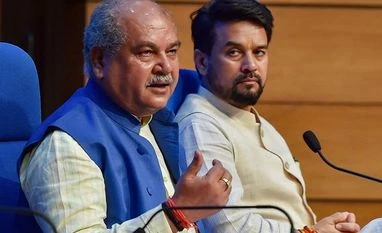With India’s edible oil imports projected to rise manifold in the coming years, the Union Cabinet today approved a new Rs 11, 040 crore mission to boost domestic palm oil production, highlight of which was a MSP-type mechanism for ensuring a bench mark assured price to farmers along with deficiency price payment through DBT.
The decision comes after Prime Minister Narendra Modi announced the new central scheme on August 15 during his Independence Day speech at Red Fort.
Recently, Yoga guru Baba Ramdev’s Patanjali group-led Ruchi Soya showed interest to start palm oil plantations in Assam, Tripura and other North-Eastern states.
Under the new assured price mechanism, the government said that it will give a price assurance to the oil palm farmers for their Fresh Fruit Bunches (FFBs).
FFBs are those from which palm oil is extracted by the industry. This will be known as the Viability Price (VP).
“This VP shall be the annual average CPO price of the last 5 years adjusted with the wholesale price index to be multiplied by 14.3 per cent," the government said in a statement.
This will be fixed yearly for the oil palm year from 1st November to 31st October.
"This assurance will inculcate confidence in the Indian oil palm farmers to go for increased area and thereby more production of palm oil. A Formula price (FP) will also be fixed which will be 14.3 percent of CPO and will be fixed on a monthly basis. The viability gap funding will be the VP-FP and if the need arises, it would be paid directly to the farmers’ accounts in the form of DBT," the statement added.
It further said that the assurance to the farmers will be in the form of the viability gap funding and the industry will be mandated to pay 14.3 per cent of the CPO price which will eventually go up to 15.3 per cent.
“This is to ensure that farmers along with industry and processors remain sufficiently invested in the project as oil palm cultivation usually has a long gestation period of over 5-7 years before it starts giving returns to farmers,” agriculture minister Narendra Singh Tomar told reporters after the meeting.
To give impetus to the North-East and the Andamans, the Government will additionally bear a cost of 2 percent of the CPO price to ensure that the farmers are paid at par with the rest of India.
That apart, the union cabinet also approved an incentive of Rs 5 crore for the oil palm processing units if they plan to set up their industry in North-Eastern states.
The input subsidy for farmers has also been increased from the current Rs 12,000 per hectare to Rs 29,000 per hectare.
“The Indian Council of Agriculture Research (ICAR) has identified that around 2.8 million hectares of land in the country is suitable for oil palm cultivation of which just around 0.9 million is in North-East India which won’t be used by cutting standing forests or shifting farmers from other crops,” Tomar assured.
He said apart from the benchmark price a special assistance at the rate of Rs 250 per plant is being given to replant old gardens for rejuvenation of old gardens.
To address the issue of shortage of planting material in the country, seed gardens will be provided assistance up to Rs 80 lakhs for 15 hectares in Rest of India and Rs 1 crore for 15 hectares in North-East and Andaman regions.
Further, assistance for seed gardens at the rate of Rs 40 lakhs and Rs 50 lakhs for Rest of India and North-East and Andaman regions respectively.
Of the total outlay of Rs 11,040 crore, Rs 8,844 crore would be the central government's share while Rs 2,196 crore would be states' share.
This includes the viability gap funding also, the official statement said.
The Target
According to officials, the new Mission plans to increase oil palm cultivation to 1 million hectares by 2025-26 and 1.7-1.8 million hectares by 2029-30.
At present, around 0.34 million hectares is under Oil Palm cultivation in India domestically largely in Andhra Pradesh and a few North-Eastern states.
The domestic palm oil production is targeted to rise by three times to 1.1 million tonnes by 2025-26 under the Mission and 2.8 million tonnes by 2029-30.
Import Dependency
India annually imports around 13-15 million tonnes of edible oil of which almost 55-60 per cent is palm oil alone. This is projected to go up 20 million tonnes by 2030 due to rising disposable incomes and changing food habits.
Palm oil is largely imported from Malaysia and Indonesia, for whom India is the biggest consumer.
Trade Reaction
Sanjay Goenka, President of Oil Palm Developers and Processors Association (OPDPA) said that Oil Palm crop is a highly remunerative crop (to the farmer) that has the potential to provide the highest return on investment per acre compared to other commercial crops.
While, Babulal Data, President, Central Organization for Oil Industry and Trade (COOIT) said the decision to compensate farmers of oil palm in case the prices falls below minimum support price and enhancement of input subsidy from Rs 12,000 per hectare to Rs 29,000 per hectare will encourage farmers to undertake cultivation of oil palm.
Unlock 30+ premium stories daily hand-picked by our editors, across devices on browser and app.
Pick your 5 favourite companies, get a daily email with all news updates on them.
Full access to our intuitive epaper - clip, save, share articles from any device; newspaper archives from 2006.
Preferential invites to Business Standard events.
Curated newsletters on markets, personal finance, policy & politics, start-ups, technology, and more.
)